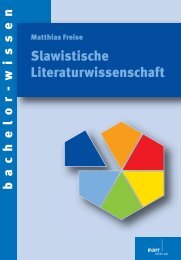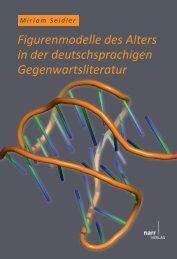Penetrating Language. A Critical Discourse Analysis ... - narr-shop.de
Penetrating Language. A Critical Discourse Analysis ... - narr-shop.de
Penetrating Language. A Critical Discourse Analysis ... - narr-shop.de
Create successful ePaper yourself
Turn your PDF publications into a flip-book with our unique Google optimized e-Paper software.
Buchreihe zu <strong>de</strong>n Arbeiten aus Anglistik und Amerikanistik<strong>Penetrating</strong> <strong>Language</strong>A <strong>Critical</strong> <strong>Discourse</strong> <strong>Analysis</strong>of Pornographyvon Georg MarkoGunter NarrVerlag Tübingen
<strong>Penetrating</strong> <strong>Language</strong>
Buchreihe zu <strong>de</strong>n Arbeiten aus Anglistik und AmerikanistikHerausgegeben von Walter Bernhart, Peter Bierbaumer, Alwin Fill,Gudrun Grabher, Arno Heller, Walter Hölbling, Allan James,Bernhard Kettemann, Christian Mair, Annemarie Peltzer-Karpf,Werner Wolf und Wolfgang ZachBand 23
Georg Marko<strong>Penetrating</strong> <strong>Language</strong>A <strong>Critical</strong> <strong>Discourse</strong> <strong>Analysis</strong>of PornographyGunter Narr Verlag Tübingen
Bibliografische Information <strong>de</strong>r Deutschen NationalbibliothekDie Deutsche Nationalbibliothek verzeichnet diese Publikation in <strong>de</strong>r Deutschen Nationalbibliografie;<strong>de</strong>taillierte bibliografische Daten sind im Internet über abrufbar.Gedruckt mit För<strong>de</strong>rung <strong>de</strong>r Karl-Franzens-Universität Graz, <strong>de</strong>s Bun<strong>de</strong>sministeriums fürWissenschaft und Forschung in Wien, <strong>de</strong>s Lan<strong>de</strong>s Steiermark sowie <strong>de</strong>r Stadt Graz.© 2008 Narr Francke Attempto Verlag GmbH + Co. KGDischingerweg 5 · D-72070 TübingenDas Werk einschließlich aller seiner Teile ist urheberrechtlich geschützt. Je<strong>de</strong> Verwertungaußerhalb <strong>de</strong>r engen Grenzen <strong>de</strong>s Urheberrechtsgesetzes ist ohne Zustimmung <strong>de</strong>s Verlagesunzulässig und strafbar. Das gilt insbeson<strong>de</strong>re für Vervielfältigungen, Übersetzungen, Mikroverfilmungenund die Einspeicherung und Verarbeitung in elektronischen Systemen.Gedruckt auf säurefreiem und alterungsbeständigem Werkdruckpapier.Internet: http://www.<strong>narr</strong>.<strong>de</strong>E-Mail: info@<strong>narr</strong>.<strong>de</strong>Druck und Bindung: Ilmprint, LangewiesenPrinted in GermanyISSN 0939-8481ISBN 978-3-8233-6380-4
ContentsPrologue...............................................................................................11Introduction........................................................................................15PART 1: THEORETICAL BACKGROUND 17I Discussing Pornography: Why People are Arguingabout Pornography 191 Defining pornography .................................................................191.1 Ontological status...................................................................201.2 Content ...................................................................................201.3 Intention (on a primary level).................................................201.4 Intention (on a secondary level).............................................211.5 Semiotic mo<strong>de</strong>s ......................................................................211.6 Contextual features.................................................................212 The issue and the camps ..............................................................222.1 Christian moralists..................................................................252.1.1 Sexual morality ............................................................262.1.2 <strong>Language</strong>......................................................................262.1.3 Regulation....................................................................272.1.4 Alternatives/Positive effects/Sex workers ...................282.2 Liberals...................................................................................282.2.1 Sexual morality ............................................................282.2.2 <strong>Language</strong>......................................................................292.2.3 Regulation....................................................................292.2.4 Alternatives..................................................................302.2.5 Positive effects .............................................................312.2.6 Sex workers..................................................................322.3 Anti-pornography Feminists ..................................................332.3.1 Sexual morality ............................................................332.3.2 <strong>Language</strong>......................................................................352.3.3 Regulation....................................................................372.3.4 Alternatives..................................................................382.3.5 Positive effects .............................................................392.3.6 Sex workers..................................................................40
6Contents2.4 Anti-censorship feminists.......................................................412.4.1 Sexual morality ............................................................422.4.2 <strong>Language</strong>......................................................................422.4.3 Regulation....................................................................442.4.4 Alternatives..................................................................442.4.5 Positive effects/Sex workers ........................................462.5 My own position ....................................................................463 Summing up..................................................................................46II Researching Pornography: Sexology and Hermeneutics 491 Sexology ........................................................................................491.1 Correlational studies...............................................................501.2 Clinical studies .......................................................................521.3 Experimental studies ..............................................................532 Hermeneutics................................................................................562.1 Evaluative surveys .................................................................582.2 Testimonial studies.................................................................592.3 Content analysis .....................................................................613 Summing up..................................................................................63III Researching Pornography: <strong>Critical</strong> <strong>Discourse</strong> <strong>Analysis</strong> 671 Hermeneutic theory I: What is discourse analytic about<strong>Critical</strong> <strong>Discourse</strong> <strong>Analysis</strong>? .......................................................681.1 Social constructionism ...........................................................691.1.1 Cognition......................................................................701.1.2 Society..........................................................................741.2 <strong>Discourse</strong> <strong>Analysis</strong>.................................................................781.2.1 <strong>Discourse</strong> as language in use .......................................791.2.2 <strong>Discourse</strong> as type of language event............................801.2.3 <strong>Discourse</strong> as concrete language event..........................811.2.4 CDA versus other linguistically-oriented approaches 822 Hermeneutic theory II: What is critical about <strong>Critical</strong><strong>Discourse</strong> <strong>Analysis</strong>? .....................................................................842.1 <strong>Critical</strong> theory.........................................................................852.2 <strong>Critical</strong> evaluation ..................................................................892.2.1 Political dimension of the research process .................90
8ContentsPART 2: ANALYSES 135Introduction to Part 2........................................................................137V Fragmentation 1411 (Over)Representing body parts: lexeme frequency andvariation......................................................................................1421.1 Technical and practical aspects of the analysis....................1451.2 Presenting and discussing overall results.............................1491.3 Comparing and discussing overall results............................1521.4 Presenting and discussing specific results............................1551.5 Comparing and discussing specific results...........................1602 Immediately attending to body parts: possessives ..................1652.1 Technical and practical aspects of the analysis....................1672.2 Presenting and discussing overall results.............................1672.3 Comparing and discussing overall results............................1682.4 Presenting and discussing specific results............................1692.5 Comparing and discussing specific results...........................1703 Casting a si<strong>de</strong> glance: interesting phenomena not examined 1724 Conclusion ..................................................................................174VI Physicalization and Visualization 1771 Describing people: attributive <strong>de</strong>scriptors ..............................1791.1 Technical and practical aspects of the analysis....................1861.2 Presenting and discussing results .........................................1931.3 Comparing and discussing results........................................1972 Describing body parts: attributive <strong>de</strong>scriptors .......................2022.1 Technical and practical aspects of the analysis....................2042.2 Presenting and discussing results .........................................2052.3 Comparing and discussing results........................................2133 Casting a si<strong>de</strong> glance: interesting phenomena not examined 2194 Conclusion ..................................................................................222VII Desubjectification 2251 Representing people’s inner lives: mental process verbs .......2281.1 Technical and practical aspects of the analysis....................230
Contents 91.2 Presenting and discussing results .........................................2351.3 Comparing and discussing results........................................2402 Marked perspective: passive voice ...........................................2462.1 Technical and practical aspects of the analysis....................2472.2 Presenting and discussing results .........................................2512.3 Comparing and discussing results........................................2523 Casting a si<strong>de</strong> glance: interesting phenomena not examined 2544 Conclusion ..................................................................................256VIII Passivization 2591 Positioning sexual partners: semantic role patterns...............2611.1 Technical and practical aspects of the analysis....................2671.2 Presenting and discussing results .........................................2731.3 Comparing and discussing results........................................2772 Representing women as empty space and men as tools:conceptual metaphors for genitals............................................2832.1 Technical and practical aspects of the analysis....................2892.2 Presenting and discussing results .........................................2932.3 Comparing and discussing results........................................3003 Casting a si<strong>de</strong> glance: interesting phenomena not examined 3084 Conclusion ..................................................................................310Conclusion: Questions, Answers and Evaluations ..................313References.........................................................................................323In<strong>de</strong>x...................................................................................................347
PrologueChorus: What are you doing here?Me: Adding the last strokes to this book, the publication of my PhDdissertation.Chorus: What is it about?Me: The language of pornography.Chorus: Why pornography?Me: Because it is a culturally contested topic. I have always wantedto do research the results of which could have some social andpolitical significance. Secondly, I wanted to write about somethingconsi<strong>de</strong>red interesting by a wi<strong>de</strong>r audience so as to makepeople who are normally unaware of the workings of languageget interested in a method of linguistic analysis that couldprove beneficial for their everyday lives.Chorus: And why language?Me: I think that a linguistic approach to social phenomena such aspornography can shed some new light on old issues.Chorus: Why have you chosen the title <strong>Penetrating</strong> <strong>Language</strong>?Me: Because… well, probably because Flying planes can bedangerous.Chorus: Huh???Me: Who or what is doing the penetrating and who or what is beingpenetrated? And what is penetration anyway?Chorus: I have seen that your data is taken from magazines bought in1995 – and this book is published in 2008. Why the large timegap?Me: If you just look at the finished product, it may be hard to seethe long and chequered <strong>de</strong>velopment behind it – even thoughsome of the inconsistencies you will without doubt <strong>de</strong>tect pointto this. When I collected data in England and the United Statesduring research stays there in 1994 and 1995, the focus of my
12Prologuestudy was much vaguer and broa<strong>de</strong>r. Selecting the best researchobjects (pornographic short stories), the appropriatemethodology (corpus analysis), and the i<strong>de</strong>al analytical framework(<strong>Critical</strong> <strong>Discourse</strong> <strong>Analysis</strong>) then took some time. Preparingthe corpus (which meant painstakingly typing hundredsof pornography stories) and <strong>de</strong>veloping my own approach to<strong>Critical</strong> <strong>Discourse</strong> <strong>Analysis</strong> – I realized that I had to <strong>de</strong>viatefrom its trod<strong>de</strong>n paths – <strong>de</strong>layed my full <strong>de</strong>dication to the projectfurther.Chorus: Isn’t it a historical study then?Me: Pornography has certainly changed in the last <strong>de</strong>ca<strong>de</strong>, particularlyconsi<strong>de</strong>ring that the time span between the mid-1990sand 2008 inclu<strong>de</strong>s the rise of the Internet, which especiallyaffected the accessibility of erotic discourses consi<strong>de</strong>rably. Onthe other hand, I suppose that my approach, focusing on fundamentalpatterns of i<strong>de</strong>as and attitu<strong>de</strong>s in discourses, can revealmore permanent properties of pornography.Chorus: What is it like to collect data in a project on pornography?Me: Tedious and emotionally exhausting because I do not have theself-confi<strong>de</strong>nce to simply walk into an adult book<strong>shop</strong> andquickly find what I am looking for. It literally took me hours toenter and then I also spent a lot of time in the <strong>shop</strong>s, alwayskeeping my gaze downwards in or<strong>de</strong>r not to acknowledge that Iwas actually there. I always felt like telling everybody, “Well, Iam doing research on pornography, I am not buying it for thesexual value,” but then I was not sure how they would havetaken this. I wanted to limit my visits and I therefore bought asmuch as was available in the field I was interested in and asmuch as I could afford. Anonymous or<strong>de</strong>rs via the Internetwere not an option at the time. I subscribed to one magazine,but that was just to get started right at the beginning andseemed not a viable solution for all the material.Chorus: Are you afraid that your research will be misun<strong>de</strong>rstood? Justthink of some of the reactions to your talks on the subject andremember the magazine using the headline “First porn doctor.”Me:There are several paths of misun<strong>de</strong>rstanding, some of which Ihave already experienced. Some people (interestingly mainlymen) in the aca<strong>de</strong>mia seem to equate the analysis of a socialphenomenon with the endorsement of the latter, thus <strong>de</strong>eming
Prologue 13my topic inappropriate. Interestingly, I had similar reactionsfrom non-aca<strong>de</strong>mics, but here the evaluation was positive.Many males, on learning what I was studying, said, “You’vecome to the right man.” They automatically assumed that I, asa male, would necessarily try to flesh out the juicy <strong>de</strong>tails ofthe language of pornography. It was impossible for them toimagine that what I was doing could be critical and distancedto the object. It gave me a new (and not really appreciated)street credibility.Chorus: Could the book be read as pornography itself so that rea<strong>de</strong>rscould be disgusted, embarrassed or even aroused?Me: I am positive that the seriousness and rigidity of my analyticapproach as well as the style of data presentation will mitigatesuch effects and that they will also discourage using quotes asporn proper (and, well, there are cheaper forms available). It isimportant to find a balance between curiosity – I guess mostrea<strong>de</strong>rs will be interested in what pornography may look like –and a scientifically distanced perspective. The curiosity shouldmake it easier to <strong>de</strong>lve into the book. But eventually, it isimportant to bear in mind that the analyses serve to answercrucial social and political questions and do not simply presentthe language of pornography, exhibiting it as fascinating and/or disgusting phenomenon.Chorus: What about the scientific community? I have got the feelingthat many will see your approach as half-hearted, doing CDA,but focusing almost exclusively on textual dimensions, andusing quantitatively-oriented corpus linguistics without applyingproper statistical procedures and without paying too muchattention to representativeness.Me:I accept these critical points without <strong>de</strong>nying that I amdissatisfied with how I handled them. To a certain extent, theproject was too ambitious right from the start, especially for asingle researcher. But I <strong>de</strong>ci<strong>de</strong>d to carry on <strong>de</strong>spite these weaknessesbecause I think that the research still yields very interestinginsights into the discourse of pornography and itspotential i<strong>de</strong>ological implications and secondly because Iwanted to show what a large-scale, strictly data-based study in<strong>Critical</strong> <strong>Discourse</strong> <strong>Analysis</strong> could look like, <strong>de</strong>monstratingwhat might go wrong and where there is room forimprovement in the process.
14PrologueThe research process was like an incomplete hermeneuticcircle: I had a vague i<strong>de</strong>a, I <strong>de</strong>ci<strong>de</strong>d on a method and anapproach, I collected material, the i<strong>de</strong>a became more concrete,the method and the approach were refined… but at a certainstage it was – for mundane reasons – not possible to go backand collect more material. So particularly in the area of corpusanalysis I got stuck at a certain point. I am well aware thatcompiling a corpus by simply including as much as is easilyavailable within a short time span, accepting that a comparativecorpus is only a third of the length of the main corpus et ceteramust seem inexcusably naïve, at best. Anyway, I am walkingthe thin line between originality, ambition and insanity.Chorus: Wasn’t the book longer? Where has all the data gone? And theglossary?Me: I ‘outsourced’ these parts to reduce the length of the book. Butyou can find all the data and the glossary on my homepage athttp://www.uni-graz.at/georg.marko.Chorus: Is this the first book you have written yourself.Me: Yes. I have edited a few volumes, but no work produce<strong>de</strong>ntirely on my own. Well, and then this is not really true eitherbecause I may have done the research and the writing, but thereare a few people who have indirectly contributed by providingvaluable critical feedback, most notably my two supervisorsProfessor Alwin Fill and Professor Bernhard Kettemann – allhat tipping to them – and by supporting me in all possible waysin the publication process, most notably Angelika Pfaller andSusanne Fischer at Gunter Narr Verlag. And then there are ofcourse those who created the social, financial and emotionalenvironment and atmosphere necessary to live and prosper anddo such work. So all thanks and more to my parents, mysisters, my grandmother, all my family and friends and thegreat sunbears of this world.… hey… what are you doing there?Chorus: Don’t worry – we are just turning the page to get it started…
IntroductionDoes pornography objectify women, representing them as passivemindless things at the mercy of male sexual agents, or does it dive intowomen’s sexual subjectivities, revealing their innermost thoughts,<strong>de</strong>sires and sensations? Does pornography subjugate women fartherun<strong>de</strong>r the patriarchal yoke, or is it a potential path of female emancipation?Does pornography corrupt the values our society is built on or doesit reveal the hypocrisy of traditional morality? Does pornography putsexuality above love, thus <strong>de</strong>stroying relationships, or does it provi<strong>de</strong> aremedy for sexual problems, thus saving relationships? Does pornographycause sex crimes or does it provi<strong>de</strong> a safety valve for potentialsexual assaultants?There are a host of questions in the discussion on pornography,questions that are evi<strong>de</strong>nce of the fact that it represents an i<strong>de</strong>al stage forcultural struggles over – among other things – sexuality, gen<strong>de</strong>r,morality, and representations. Although answers to these questions areprimarily informed by <strong>de</strong>eply rooted i<strong>de</strong>ological views of sexualmorality, the different camps have never been reluctant to cite scientificstudies corroborating their positions. Research into pornographytherefore plays a seminal role in the <strong>de</strong>bate, even if walking on i<strong>de</strong>ologicallyswampy ground.This book presents further research into pornography. Like the researchthat has been done before, it tries to find answers to some of thequestions emerging from the socio-political <strong>de</strong>bate, in particular thosecentring on the issue of objectification. Unlike prior research, however,it starts at the very thing that constitutes pornography, namely atlanguage. It is the first large-scale study of pornography in the traditionof <strong>Critical</strong> <strong>Discourse</strong> <strong>Analysis</strong> (henceforth CDA). CDA assumes thatbeing exposed to language and particular ways of using language has aneffect on the receivers’ knowledge and views of the world. By focusingon the ‘nitty gritty’ <strong>de</strong>tails of the language used in a large collection ofpornographic short stories, I will therefore reveal aspects likely to becontained in the conceptions of the world or, more specifically, ofsexuality and female and male sexual roles created in consumers ofpornography, partly in comparison to those of consumers of theallegedly softer form of sexual representation, namely of erotica.
16IntroductionThe book also has a secondary objective: <strong>Critical</strong> <strong>Discourse</strong><strong>Analysis</strong> may be solidly foun<strong>de</strong>d on a set of social goals but it still sadlylacks a common linguistic metatheory and methodology. Authors ofbook-length analyses therefore are also confronted with the task ofcontributing to CDA’s metatheoretical and methodological basis (cf.Fowler 1996: 8f.). Such a contribution involves making fundamentalprinciples explicit and discussing them as well as using the analyses to<strong>de</strong>monstrate their relevance and feasibility. In the process, the analysesare also inten<strong>de</strong>d to evi<strong>de</strong>nce how a quantitatively-oriented linguisticdiscourse analysis of sexual texts may provi<strong>de</strong> an alternative route to thescientific study of sexuality, going beyond the sexological paradigm oflaboratory experiments and questionnaire surveys, but without resortingto intuitive speculation.A caveat: the methodological and metatheoretical (si<strong>de</strong>)focus doesnot imply that I will present the study as a perfect mo<strong>de</strong>l. On thecontrary, I will try to be as critical as possible, making shortcomings,errors, misconceptions, inconsistencies and other types of ‘incubi’haunting science as explicit as possible.The book is divi<strong>de</strong>d into two large parts, the first one <strong>de</strong>dicated tothe theoretical background and the second one to the analyses proper.Part 1 proceeds from a <strong>de</strong>scription of the pornography <strong>de</strong>bate and areview of research into pornography and its methodologies to theintroduction of <strong>Critical</strong> <strong>Discourse</strong> <strong>Analysis</strong> as a valuable and viablealternative approach. It further outlines the basic features of CDA asused in my research. Part 1 ends in a set of hypotheses.Part 2 takes up the hypotheses and examines whether they can beupheld in an analysis of a corpus of pornographic short stories and acomparative analysis of a corpus of erotica.
PART 1:THEORETICAL BACKGROUND
IDiscussing Pornography: Why Peopleare Arguing about PornographyTheir basic query is not what about equality but what about orgasm.Catharine MacKinnon (1992b: 134)There has always been a heated controversy over pornography, raisingmany issues viewed and approached very differently. A study of pornographicrepresentations cannot afford to ignore these discussions becauseno matter what my intentions are, simply by studying the phenomenon Iam entering the <strong>de</strong>bate. A thorough presentation of why and how pornographyhas become a topic so fiercely and controversially discussed,which aspects have come to the fore and appear to be particularlyrelevant and <strong>de</strong>licate, and which groups have participated in the <strong>de</strong>batewill pave the way for an analysis which is not purely and blindfol<strong>de</strong>dlyaca<strong>de</strong>mic but which is aware of its social role, its obligations and itsresponsibilities. This chapter is inten<strong>de</strong>d to fulfil these requirements.After presenting my own <strong>de</strong>finition of pornography, I will <strong>de</strong>scribethe issues that are at the core of the matter and on which the fourmain camps strongly disagree.1 Defining pornographyJustice Potter Stewart, unable to come up with his own <strong>de</strong>finition ofpornography, resorted to the infamous characterization, “I know it, whenI see it” (Johann/Osanka 1989: 3). This is an indication that, though wemay have an intuitive grasp of the concept of pornography, <strong>de</strong>fining it isnot as straightforward a task. It no longer simply is the writing (-graphy)of prostitutes (porno-) (cf. Linz/Malamuth 1993: 2), as its etymologysuggests, but today’s pornography is a complex social phenomenon.Although past centuries saw texts and art with aspects that couldbe classified as pornographic (cf. Kendrick 1987, Hunt 1993, McNair1996, Tang 1999), these artefacts lacked many of the features of currentpornography, which have only emerged in the 20 th century and particularlysince the sexual revolution of the 1960s as a result of technologicalprogress and the changing cultural climate. I will restrict myself topornography as a contemporary phenomenon in my study.
20Theoretical BackgroundIn the following, I will give six <strong>de</strong>fining features of pornographythat distinguish it from similar cultural products.1.1 Ontological statusPornography is not a sexual practice itself, it is just a common way oftalking or writing about sexual practices, a common way of representingsexual practices. Pornography is thus, to use the technical term, a sexualdiscourse 1 (cf. Cameron 1990a, 1992a, Cameron/Frazer 1992, Hardy1998), with the headword in pornography being graphy, i.e. the writing,rather than porno, i.e. the whores (cf. Kappeler 1986: 2).Although I consi<strong>de</strong>r this an essential feature of pornography, it hasto be mentioned that the difference between represented practices andpractices proper is becoming more and more blurred and there are manythat say a discourse can also become a sexual practice in itself (cf.Baudrillard 1990: 28ff., MacKinnon 1992a: 462, both cit. in Bristow1997: 145, 153). The bor<strong>de</strong>rline becomes particularly fuzzy with telephonesex or interactive sex chats on the Internet.1.2 ContentPornography’s content is first and foremost sexual explicitness, i.e. theimmediate and unmitigated <strong>de</strong>scription of the physical, physiologicaland perceptive (i.e. what it looks like and what it ‘feels like’) <strong>de</strong>tails ofsexuality (cf. Williams 1979: 103, cit. in Einsie<strong>de</strong>l 1988: 109). Althoughother material, e.g. ‘high’ literature on sex or erotica, might also featureunmasked sexuality, pornography usually exceeds it in the sheer quantityof sexually explicit scenes (by three to eighteen times, according to acontent analysis by Smith 1976: 19f.).1.3 Intention (on a primary level)Pornography’s main (and perhaps its sole) intention is to arouse rea<strong>de</strong>rs(cf. Williams 1979: 103, cit. in Einsie<strong>de</strong>l 1988: 109, Soble 1985: 8,Christensen 1990: 1, McNair 1996: 57). Unlike other sexual discoursessuch as educational material or erotica, pornography lacks any culturallyrevered aspects: it does neither impart scientific knowledge of sexualitynor does it have any aesthetic or literary pretensions (cf. Attorney1 For the time being, it suffices to <strong>de</strong>fine a discourse as a common way ofrepresenting things such as sexual practices (but see section III.1.2).
22Theoretical Backgroundbecoming circular, and empirical studies would be ren<strong>de</strong>red meaninglessand thus redundant. If pornography is <strong>de</strong>fined, for instance, asmisogynist, then we cannot find it to be non-sexist through research (afemale form would also be inconceivable by <strong>de</strong>finition). Dines andJensen (1998b: 65) are right in claiming that it is the task of research toshow that pornography in the former sense has the features attributed toit by feminists and/or conservatives.I will not distinguish between different forms of pornography onthe basis of explicitness and uncommonness of the practices representedin this book. The distinction between hard-core and soft-core (cf.Easton 1994: xvi, Hardy 1998: 50, Dines 1998a: 63) might beeconomically and legally justified – hard-core pornography, for instance,is practically exclu<strong>de</strong>d from mainstream distribution outlets in theUnited States (cf. Dines 1998a: 54) and, in its visual form, prohibited inBritain (cf. Hardy 1998: 51). But from my point of view, thedifferentiation is a matter of <strong>de</strong>gree and therefore not useful in myproject. Besi<strong>de</strong>s, it is only valid in pictorial pornography, which meansthe distinctions mentioned do not apply to written material (cf. Ellis1988, cit. in Hardy 1998: 50).The above <strong>de</strong>finition of pornography should be sufficient forprototypically characterizing the object of discussion and analysis andhas informed my selection of the data for my project. Although there arebor<strong>de</strong>rline cases, they will not figure prominently in my study.2 The issue and the campsOpinions are wi<strong>de</strong>ly divi<strong>de</strong>d about many aspects of pornography: aboutits aesthetic and literary values, its educational usefulness, or its status asa multi-million dollar business. What is at the heart of the <strong>de</strong>bate aboutpornography, however, are its possible harmful effects: Can pornographytrigger patterns of thinking and/or behaviour harmful to societyas a whole or to particular groups within society, un<strong>de</strong>rmining publicmorality and/or working in favour of the more powerful social groups?The <strong>de</strong>licate nature of pornography’s harmfulness – and the reasonwhy it has attracted more attention than that of other media supposed tomanipulate their consumers – also lies in its unique link to sexualpleasure. Particularly feminists are afraid that sexualizing the negativeeffects mitigates them in the consumers’ eyes, making them seem lessserious – after all, what turns people on cannot be that bad (cf. Kappeler1986, Itzin 1992a, Russo 1998a). But there is also a second, moregeneral consequence of the connection to sexuality: <strong>de</strong>prived of its
















